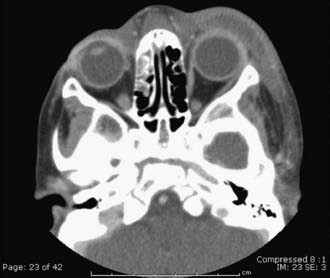Chapter 626 Orbital Infections
Orbital infections are common in children. It is important to be able to distinguish the different forms of infection that occur in the orbital region to allow rapid diagnosis and treatment to prevent loss of vision or spread of the infection to the nearby intracranial structures (see Table 618-1).
Preseptal Cellulitis
Inflammation of the lids and periorbital tissues without signs of true orbital involvement (such as proptosis or limitation of eye movement) is generally referred to as periorbital or preseptal cellulitis and is a form of facial cellulitis. This is common in young children and may be caused by bacteremia, trauma, an infected wound, or an abscess of the lid or periorbital region (pyoderma, hordeolum, conjunctivitis, dacryocystitis, insect bite). Patients present with eyelid swelling; the edema may be so intense as to make it difficult to evaluate the globe. Prior to the Haemophilus influenzae type B vaccine, the most common cause of pediatric preseptal (facial) cellulitis was bacteremia due to H. influenzae type B. Group A streptococcal infection a common is cause. Clinical examination shows lack of proptosis, normal ocular movement, and normal pupil function. CT examination demonstrates edema of the lids and subcutaneous tissues anterior to the orbital septum (Fig. 626-1). Antibiotic therapy and careful monitoring for signs of sepsis and local progression are essential.




